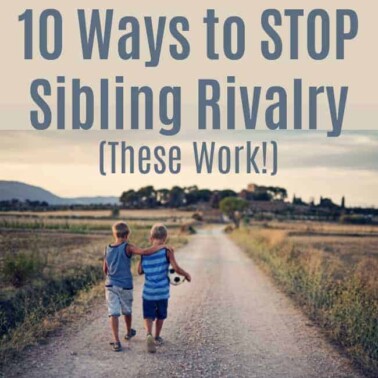This post may contain affiliate links. Please read our disclosure policy.
My friend, Stefanie, is here to share tips about how to stop a child from whining. As the mom of a young child herself, she knows that it is a step in preschooler and toddler development, so her tips are spot-on…
Take it away…
“What can you do about a child always whining?
Somehow, these little cuties know how to turn into little monsters at exactly the wrong moment.
Even the calmest mama will most likely get frustrated and yell at her little one at some point even though she knows that it’s likely not the best method for taming the whining.
Whining has a way of raising a mama’s blood pressure.
But the tricky part is that, sometimes, even when parents stay calm, they end up using techniques to stop toddler whining that actually increases the behavior.
(If you’ve ever responded to your kid’s whining by saying something like “Sweetheart, we don’t continue to whine to get what we want” then keep reading, Mama! I’ve got some great stuff for you!)
There are so many “techniques” out there for how to get a preschooler or toddler to stop whining, it’s no wonder that you aren’t sure how to respond!
The truth is that there is no one technique that will fix all your problems. Instead, you’ve got to know a little bit about all the techniques and exactly when you should use them.
Before you take action, take count of your child’s demeanor
When a young child starts using that whiny voice, it’s almost always born out of frustration. That frustration could be due to many things. As a mom, you’ve got to put your detective cap on and figure out what to do.
Before you take any sort of action… you should first take note of the way your child is behaving, what time of day it is, and any other physical factors that might be causing the whining.
The good news is that if your child starts whining due to an environmental factor like hunger or being tired, it may be a pretty easy fix. (Even big kids often misbehave when they are tired)
A simple snack, a nap, or even a hug could be all your child needs to calm down and move on. Just be careful not to turn a hug into a long cuddle session. This may actually encourage reinforce the behavior in the long run.
If you notice that your child is whining all the time, your child may just need to get more sleep. You’ll want to consider changing up your child’s schedule to allow for more sleep or quiet times.
If your child’s whining isn’t due to something environmental, then you’ll want to consider one of these behavior-changing techniques!
Planned Ignoring
For the first time in your life, ignoring someone may actually be the right thing to do! But be careful mama, planned ignoring is not the same as “tuning out.”
Planned ignoring is a variation on timeout where you basically withdraw your attention from your child until his behavior is acceptable. Once your child’s behavior returns to a normal level, you intentionally take note of him and give him the parental attention he wants.
This will help teach your child to understand that getting what he wants typically comes from good behavior.
Why it works:
Remember that your child is looking for your attention. In fact, if he could get you to pay attention to only him for all 24 hours of your day, he would… probably still want more.
By responding to your little one’s high pitched whines (even with a regular voice and a calm demeanor) you are giving your child exactly what they are asking for, your attention. Suddenly your child realizes that whining will get him a lot farther than asking nicely.
3 Strikes and You’re Out
Sometimes, allowing your child to “whine” down isn’t an option (think grocery store).
In this case, you’ll want to use a variation on that method that may get your child calm more quickly.
In the Three Strikes method, you are giving your child a limited time to get control of their whining. Basically, you’ll give your child two chances to change their behavior before implementing a consequence.
When your children whine, you’ll hold up one finger and say, “stop whining and use words.” Give your child about 5 seconds to get a handle on themselves.
If they don’t respond, put up a second finger and say “I asked you to stop whining and use your words.”
If your child still doesn’t respond, you hold up your third finger and say, “three strikes – you’re out.”
This is when you’ll want to implement the consequence. That could be anything from leaving the store to removing a toy that your child is currently playing with.
Just be aware that the first few times you use this method, your child will likely throw a temper tantrum when you implement the consequence.
Stand your ground Mama, you ARE making progress.
WHY IT WORKS:
Toddlers and preschoolers really need structure. Their brain development is still at a stage where things are very concrete. This method will offer a concrete understanding of what happens when we whine.
Redirection
Sometimes, your toddler whines for good reason. Maybe he’s broken his favorite toy or his playmate snatched something away from him. Still, allowing him to whine in response would be sending the wrong message.
Instead of that, you can use redirection to move your child’s attention away from the source of his frustration.
The good news is that children are usually pretty easy to distract by simply talking about something else or pulling out a new toy with some measure of excitement.
Bonus tip: If you’re really in a pinch and can’t let your child whine or implement a consequence (think church), then redirection is a quick and easy way to stop the whining. Just remember not to spend long minutes engaging attention-seeking behavior!
WHY IT WORKS:
Young children have poor self-control and sometimes need to be distracted from the “problem” at hand. Fortunately, they also have short attention spans and poor short-term memory, which makes redirection a pretty simple short-term fix.
Look for Teachable Moments
Toddlers and even some preschoolers are not terribly aware of the world around them. Research shows us that generally, toddlers are ego-centric (centered on their own thoughts, wants, and needs.)
As they grow, they begin to learn that other people have feelings by coming in contact with that concept repeatedly.
Shows like Mr. Rogers Neighborhood and now, Daniel Tiger’s Neighborhood have sought to teach little ones about the importance of feelings, our own, and the feelings of others.
But pointing out real-world examples is a great way for your child to start making those connections.
When you see a child throwing a tantrum on a walk or whining because they want something, it would be a great time to say something like, “Boy I wonder what he’s upset about. Maybe he really wants to go to a friend’s house and his mommy said that they have to go home instead. What do you think?”
Then go on to talk about better ways to ask for things that you would like. Talk about why we can’t always have what we want, etc.
Having intentional conversations when your child is in a calm state will help put your child’s social-emotional growth well ahead of the norm!
Now you’re armed with the techniques you need to get your child to stop whining!
Good luck, Mama! They don’t call them the terrible two’s for nothing!















